Overpopulation is a Myth: Debunking the Population Myth
VerifiedAdded on 2023/06/03
|5
|734
|244
AI Summary
This article challenges the myth of overpopulation and argues that the rich consume disproportionately to the poor, causing resource decline and environmental pollution. It also discusses the political ideology of pro-poor leftism.
Contribute Materials
Your contribution can guide someone’s learning journey. Share your
documents today.
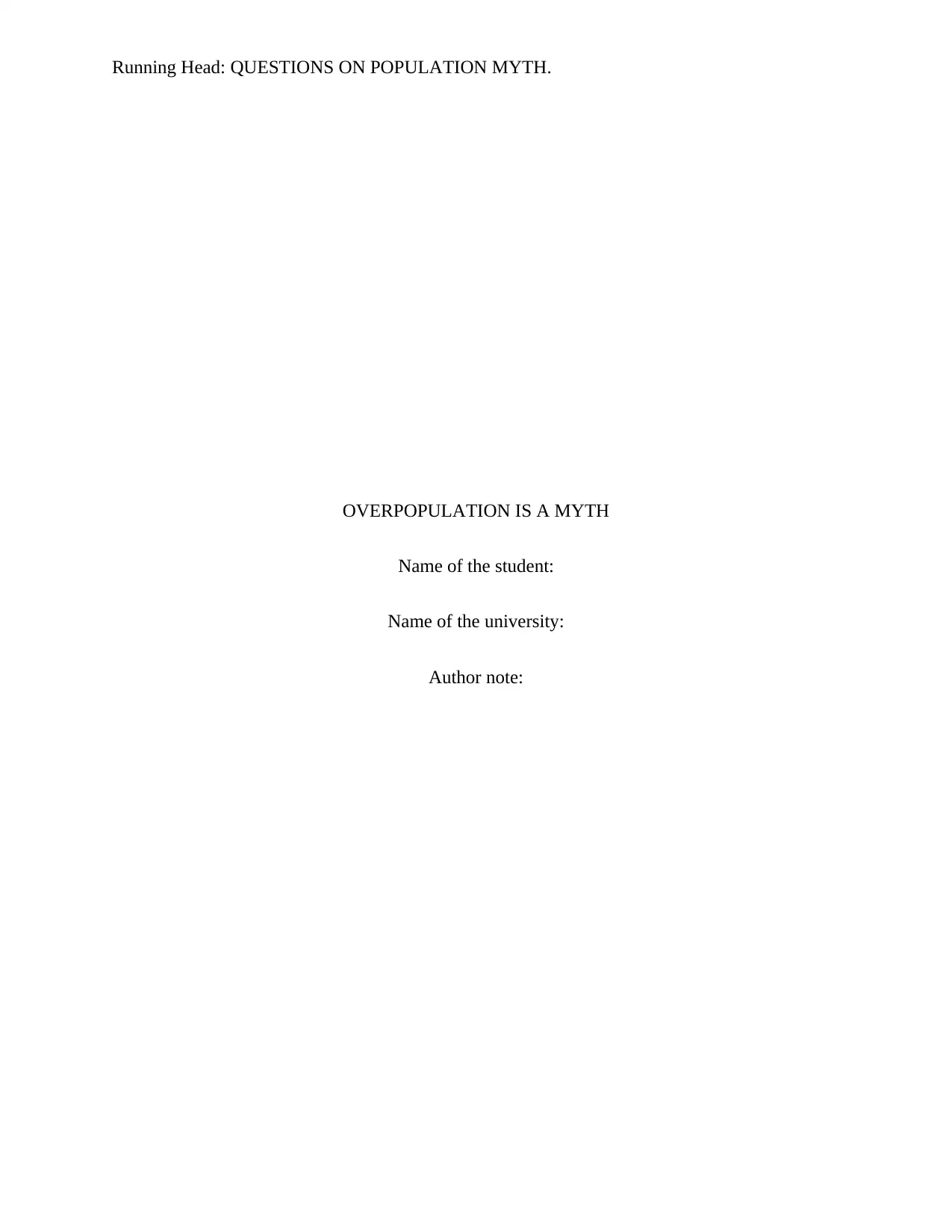
Running Head: QUESTIONS ON POPULATION MYTH.
OVERPOPULATION IS A MYTH
Name of the student:
Name of the university:
Author note:
OVERPOPULATION IS A MYTH
Name of the student:
Name of the university:
Author note:
Secure Best Marks with AI Grader
Need help grading? Try our AI Grader for instant feedback on your assignments.
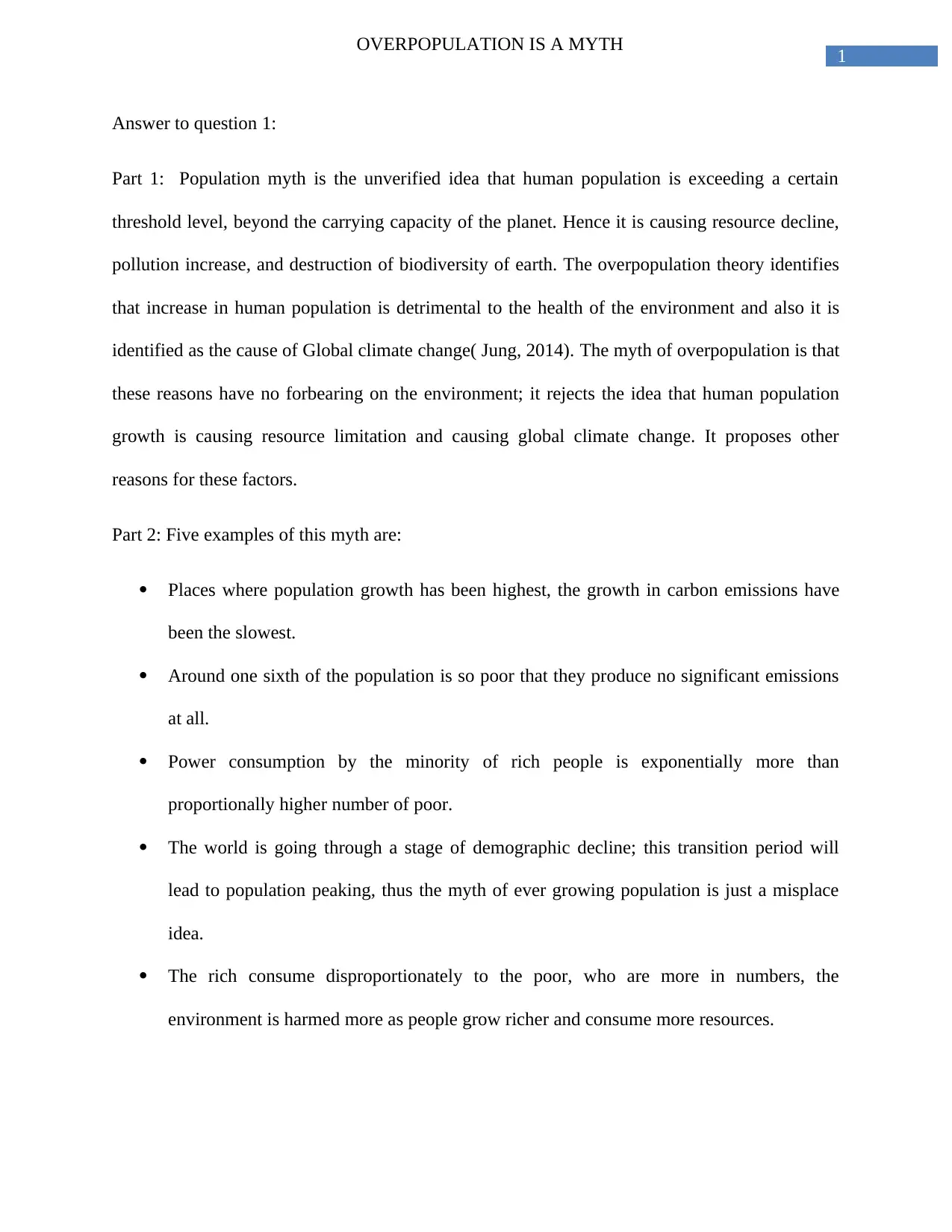
1
OVERPOPULATION IS A MYTH
Answer to question 1:
Part 1: Population myth is the unverified idea that human population is exceeding a certain
threshold level, beyond the carrying capacity of the planet. Hence it is causing resource decline,
pollution increase, and destruction of biodiversity of earth. The overpopulation theory identifies
that increase in human population is detrimental to the health of the environment and also it is
identified as the cause of Global climate change( Jung, 2014). The myth of overpopulation is that
these reasons have no forbearing on the environment; it rejects the idea that human population
growth is causing resource limitation and causing global climate change. It proposes other
reasons for these factors.
Part 2: Five examples of this myth are:
Places where population growth has been highest, the growth in carbon emissions have
been the slowest.
Around one sixth of the population is so poor that they produce no significant emissions
at all.
Power consumption by the minority of rich people is exponentially more than
proportionally higher number of poor.
The world is going through a stage of demographic decline; this transition period will
lead to population peaking, thus the myth of ever growing population is just a misplace
idea.
The rich consume disproportionately to the poor, who are more in numbers, the
environment is harmed more as people grow richer and consume more resources.
OVERPOPULATION IS A MYTH
Answer to question 1:
Part 1: Population myth is the unverified idea that human population is exceeding a certain
threshold level, beyond the carrying capacity of the planet. Hence it is causing resource decline,
pollution increase, and destruction of biodiversity of earth. The overpopulation theory identifies
that increase in human population is detrimental to the health of the environment and also it is
identified as the cause of Global climate change( Jung, 2014). The myth of overpopulation is that
these reasons have no forbearing on the environment; it rejects the idea that human population
growth is causing resource limitation and causing global climate change. It proposes other
reasons for these factors.
Part 2: Five examples of this myth are:
Places where population growth has been highest, the growth in carbon emissions have
been the slowest.
Around one sixth of the population is so poor that they produce no significant emissions
at all.
Power consumption by the minority of rich people is exponentially more than
proportionally higher number of poor.
The world is going through a stage of demographic decline; this transition period will
lead to population peaking, thus the myth of ever growing population is just a misplace
idea.
The rich consume disproportionately to the poor, who are more in numbers, the
environment is harmed more as people grow richer and consume more resources.
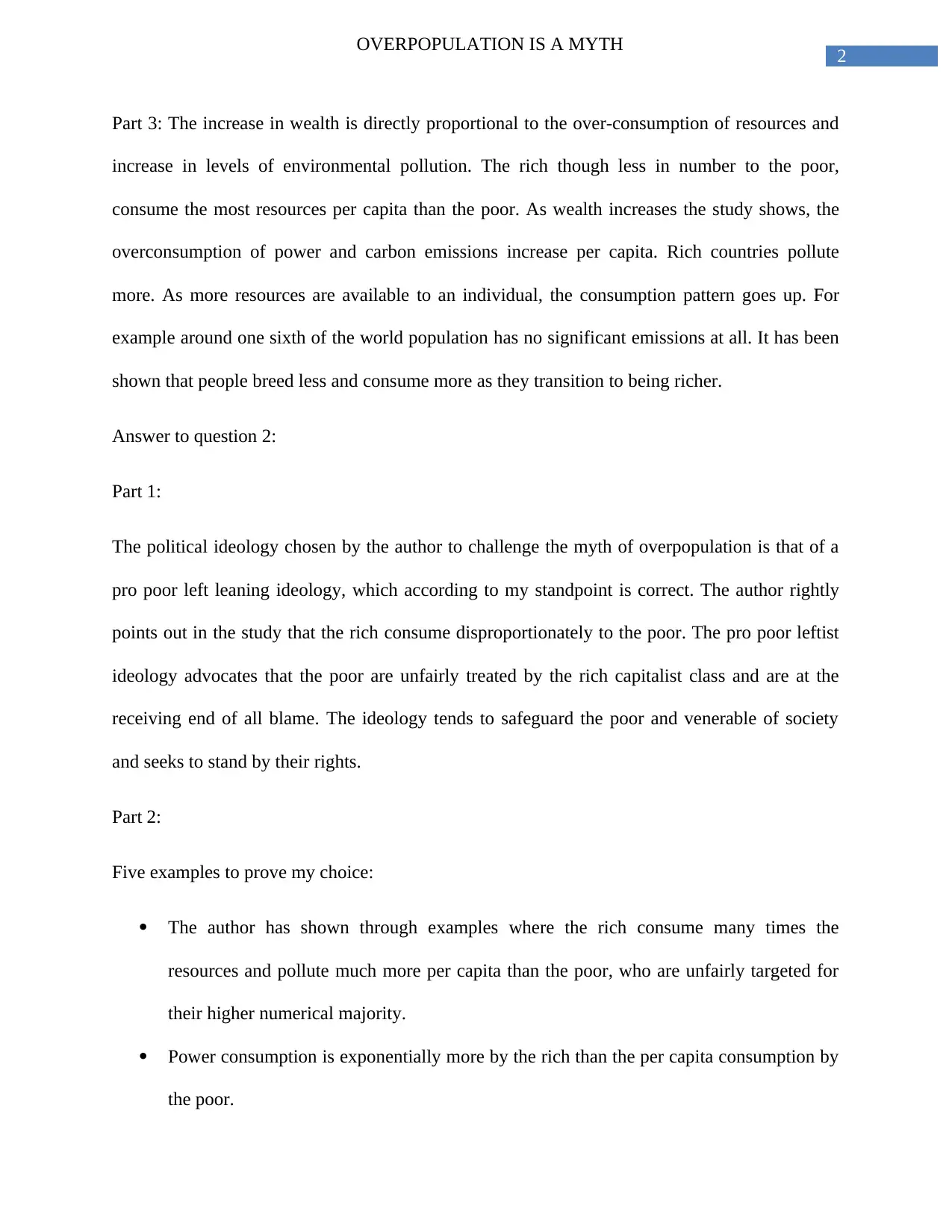
2
OVERPOPULATION IS A MYTH
Part 3: The increase in wealth is directly proportional to the over-consumption of resources and
increase in levels of environmental pollution. The rich though less in number to the poor,
consume the most resources per capita than the poor. As wealth increases the study shows, the
overconsumption of power and carbon emissions increase per capita. Rich countries pollute
more. As more resources are available to an individual, the consumption pattern goes up. For
example around one sixth of the world population has no significant emissions at all. It has been
shown that people breed less and consume more as they transition to being richer.
Answer to question 2:
Part 1:
The political ideology chosen by the author to challenge the myth of overpopulation is that of a
pro poor left leaning ideology, which according to my standpoint is correct. The author rightly
points out in the study that the rich consume disproportionately to the poor. The pro poor leftist
ideology advocates that the poor are unfairly treated by the rich capitalist class and are at the
receiving end of all blame. The ideology tends to safeguard the poor and venerable of society
and seeks to stand by their rights.
Part 2:
Five examples to prove my choice:
The author has shown through examples where the rich consume many times the
resources and pollute much more per capita than the poor, who are unfairly targeted for
their higher numerical majority.
Power consumption is exponentially more by the rich than the per capita consumption by
the poor.
OVERPOPULATION IS A MYTH
Part 3: The increase in wealth is directly proportional to the over-consumption of resources and
increase in levels of environmental pollution. The rich though less in number to the poor,
consume the most resources per capita than the poor. As wealth increases the study shows, the
overconsumption of power and carbon emissions increase per capita. Rich countries pollute
more. As more resources are available to an individual, the consumption pattern goes up. For
example around one sixth of the world population has no significant emissions at all. It has been
shown that people breed less and consume more as they transition to being richer.
Answer to question 2:
Part 1:
The political ideology chosen by the author to challenge the myth of overpopulation is that of a
pro poor left leaning ideology, which according to my standpoint is correct. The author rightly
points out in the study that the rich consume disproportionately to the poor. The pro poor leftist
ideology advocates that the poor are unfairly treated by the rich capitalist class and are at the
receiving end of all blame. The ideology tends to safeguard the poor and venerable of society
and seeks to stand by their rights.
Part 2:
Five examples to prove my choice:
The author has shown through examples where the rich consume many times the
resources and pollute much more per capita than the poor, who are unfairly targeted for
their higher numerical majority.
Power consumption is exponentially more by the rich than the per capita consumption by
the poor.
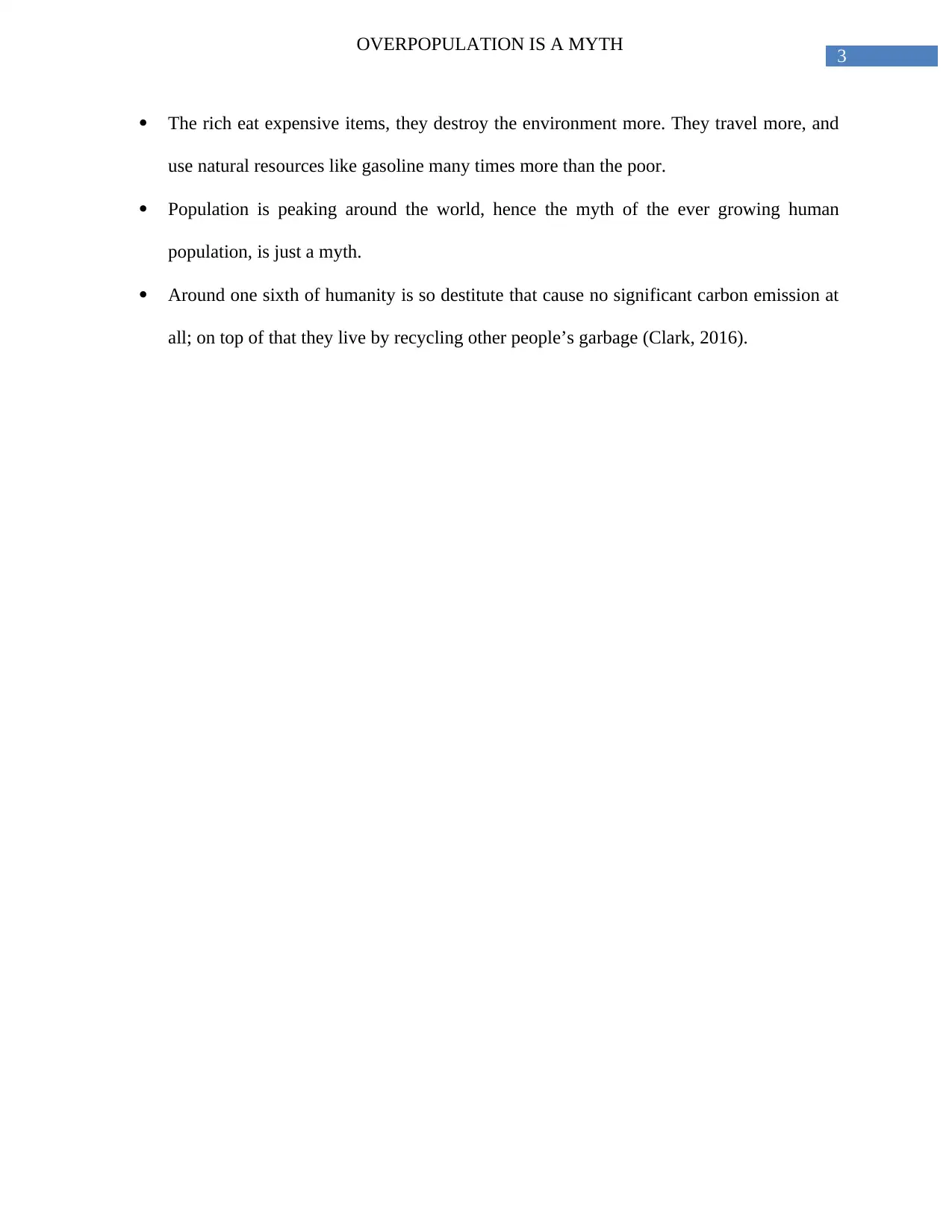
3
OVERPOPULATION IS A MYTH
The rich eat expensive items, they destroy the environment more. They travel more, and
use natural resources like gasoline many times more than the poor.
Population is peaking around the world, hence the myth of the ever growing human
population, is just a myth.
Around one sixth of humanity is so destitute that cause no significant carbon emission at
all; on top of that they live by recycling other people’s garbage (Clark, 2016).
OVERPOPULATION IS A MYTH
The rich eat expensive items, they destroy the environment more. They travel more, and
use natural resources like gasoline many times more than the poor.
Population is peaking around the world, hence the myth of the ever growing human
population, is just a myth.
Around one sixth of humanity is so destitute that cause no significant carbon emission at
all; on top of that they live by recycling other people’s garbage (Clark, 2016).
Secure Best Marks with AI Grader
Need help grading? Try our AI Grader for instant feedback on your assignments.
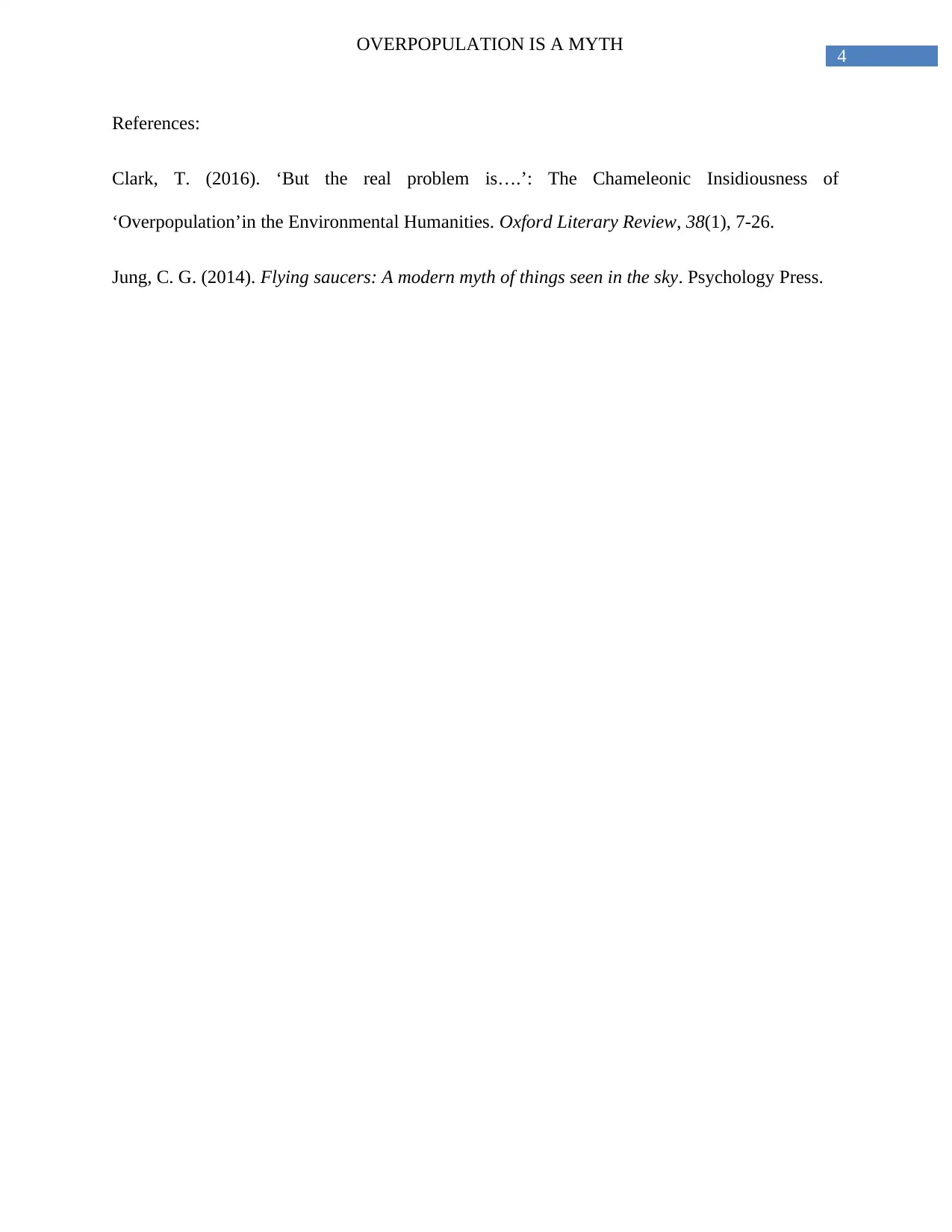
4
OVERPOPULATION IS A MYTH
References:
Clark, T. (2016). ‘But the real problem is….’: The Chameleonic Insidiousness of
‘Overpopulation’in the Environmental Humanities. Oxford Literary Review, 38(1), 7-26.
Jung, C. G. (2014). Flying saucers: A modern myth of things seen in the sky. Psychology Press.
OVERPOPULATION IS A MYTH
References:
Clark, T. (2016). ‘But the real problem is….’: The Chameleonic Insidiousness of
‘Overpopulation’in the Environmental Humanities. Oxford Literary Review, 38(1), 7-26.
Jung, C. G. (2014). Flying saucers: A modern myth of things seen in the sky. Psychology Press.
1 out of 5
Your All-in-One AI-Powered Toolkit for Academic Success.
+13062052269
info@desklib.com
Available 24*7 on WhatsApp / Email
![[object Object]](/_next/static/media/star-bottom.7253800d.svg)
Unlock your academic potential
© 2024 | Zucol Services PVT LTD | All rights reserved.
